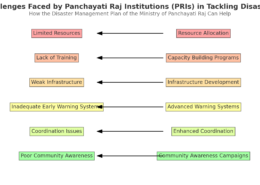What role can technology and innovation play in enhancing disaster management capabilities in developing countries, such as leveraging artificial intelligence (AI) for early detection of hazards and improving communication during crises?
Here is the infographic that highlights the challenges faced by Panchayati Raj Institutions (PRIs) in tackling disasters and how the Disaster Management Plan of the Ministry of Panchayati Raj can help address these challenges.
Here is the infographic that highlights the challenges faced by Panchayati Raj Institutions (PRIs) in tackling disasters and how the Disaster Management Plan of the Ministry of Panchayati Raj can help address these challenges.
See less

Technology and innovation can significantly enhance disaster management capabilities in developing countries by improving early detection of hazards and communication during crises. Leveraging advanced technologies, such as artificial intelligence (AI), can make a substantial difference in how theseRead more
Technology and innovation can significantly enhance disaster management capabilities in developing countries by improving early detection of hazards and communication during crises. Leveraging advanced technologies, such as artificial intelligence (AI), can make a substantial difference in how these countries prepare for and respond to disasters.
AI can be used for early detection of hazards by analyzing vast amounts of data from various sources, such as weather patterns, seismic activity, and social media trends. Machine learning algorithms can identify patterns and predict potential disasters, providing early warnings that can save lives. For instance, AI can forecast hurricanes, earthquakes, and floods more accurately, allowing for timely evacuations and preparations.
Moreover, technology can improve communication during crises, which is crucial for effective disaster management. Mobile applications and social media platforms can disseminate real-time information to affected populations, ensuring they receive critical updates and instructions. Satellite communication systems can be deployed to maintain connectivity in remote areas where traditional networks might fail during disasters.
Innovative tools like drones can be utilized for damage assessment and delivering supplies to inaccessible regions, ensuring that aid reaches those in need promptly. Additionally, geographic information systems (GIS) can map disaster-affected areas, aiding in efficient resource allocation and response planning.
However, challenges such as lack of infrastructure, digital literacy, and funding need to be addressed to fully harness the potential of technology in disaster management. Investing in technological infrastructure, training programs, and international collaboration can help developing countries overcome these hurdles and build more resilient disaster management systems.
See less